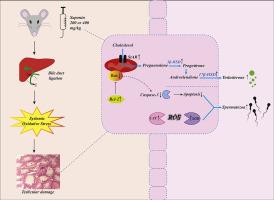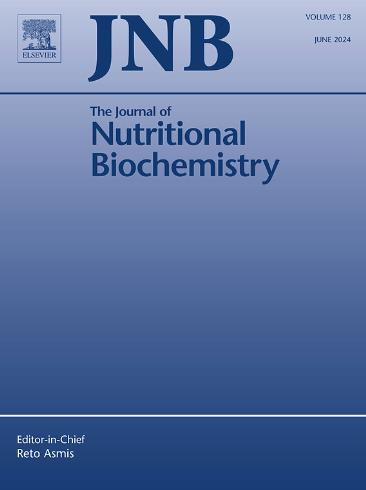Effects of saponin on testes oxidative stress, apoptosis, and steroid hormone synthesis pathway in bile duct ligation model of obstructive cholestasis in male Wistar rats
IF 4.9
2区 医学
Q1 BIOCHEMISTRY & MOLECULAR BIOLOGY
引用次数: 0
Abstract
Cholestasis occurs when bile flow is disrupted and toxic bile acids accumulate in the liver. This leads to systemic oxidative stress that may affect other organs including the testes. Cholestasis can cause testicular dysfunction. Saponins have antioxidant capacity and can elevate testosterone levels. In this study, a bile duct ligation (BDL) model of cholestasis has been used to assess the effects of cholestasis on antioxidant activity, apoptosis, steroid hormone synthesis pathway, and histopathological changes in testes and then evaluate the capability of saponin in attenuation of the injuries. We performed an in vivo study and experimental groups were as follows: control (healthy rats+0.5 mL distilled water); sham (laparotomy without BDL); saponin control (200 or 400 mg/kg); BDL; and saponin treatment (BDL rats+200 or 400 mg/kg saponin). Catalase (CAT) and superoxide dismutase (SOD) activity was evaluated by enzyme-linked immunosorbent assay (ELISA) and protein expression was assessed by Western blotting. Hematoxylin & Eosin staining was done for histopathological analysis. The results indicated that BDL reduced CAT and SOD activity and stimulated apoptosis. Moreover, protein expression of Steroidogenic acute regulatory protein (StAR), 3β-hydroxysteroid dehydrogenase (3β-HSD), and 17β-hydroxysteroid dehydrogenase (17β-HSD) was down-regulated and histopathological changes occurred. Saponin could increase SOD and CAT activity and decrease apoptosis. Also, StAR, 17β-HSD, and 3β-HSD expression were increased by saponin. In addition, histological changes were ameliorated by saponin treatment. All these data indicate that saponin may effectively reverse the modifications caused by cholestasis in the testes.

皂苷对梗阻性胆汁淤积雄性Wistar大鼠胆管结扎模型睾丸氧化应激、细胞凋亡及类固醇激素合成途径的影响。
背景:胆汁淤积症发生时,胆汁流动中断和有毒的胆汁酸积累在肝脏。这会导致系统性氧化应激,可能影响包括睾丸在内的其他器官。胆汁淤积可引起睾丸功能障碍。皂苷具有抗氧化能力,可以提高睾丸激素水平。目的:本研究采用胆管结扎(BDL)胆淤积模型,评估胆淤积对睾丸抗氧化活性、细胞凋亡、类固醇激素合成途径及组织病理学改变的影响,并评价皂苷对胆淤积损伤的抑制作用。研究设计:我们进行了体内研究,实验组为:对照组(健康大鼠+0.5 ml蒸馏水);假手术(无BDL剖腹手术);皂苷控制(200或400 mg/kg);BDL;和皂素处理(BDL大鼠+200或400 mg/kg皂素)。方法:采用酶联免疫吸附试验(ELISA)检测过氧化氢酶(CAT)和超氧化物歧化酶(SOD)活性,Western blotting检测蛋白表达。苏木精和伊红染色进行组织病理学分析。结果:BDL可降低CAT、SOD活性,促进细胞凋亡。体源性急性调节蛋白(StAR)、3β-羟基类固醇脱氢酶(3β-HSD)、17β-羟基类固醇脱氢酶(17β-HSD)蛋白表达下调并发生组织病理改变。皂苷能提高SOD和CAT活性,减少细胞凋亡。皂苷增加了StAR、17β-HSD和3β-HSD的表达。此外,皂苷处理可改善组织学改变。结论:皂苷能有效逆转睾丸胆汁淤积引起的改变。
本文章由计算机程序翻译,如有差异,请以英文原文为准。
求助全文
约1分钟内获得全文
求助全文
来源期刊

Journal of Nutritional Biochemistry
医学-生化与分子生物学
CiteScore
9.50
自引率
3.60%
发文量
237
审稿时长
68 days
期刊介绍:
Devoted to advancements in nutritional sciences, The Journal of Nutritional Biochemistry presents experimental nutrition research as it relates to: biochemistry, molecular biology, toxicology, or physiology.
Rigorous reviews by an international editorial board of distinguished scientists ensure publication of the most current and key research being conducted in nutrition at the cellular, animal and human level. In addition to its monthly features of critical reviews and research articles, The Journal of Nutritional Biochemistry also periodically publishes emerging issues, experimental methods, and other types of articles.
 求助内容:
求助内容: 应助结果提醒方式:
应助结果提醒方式:


